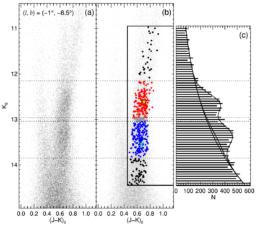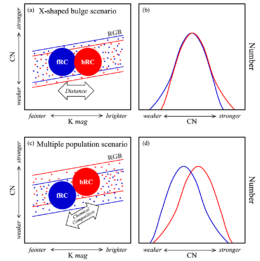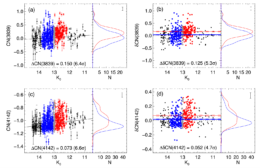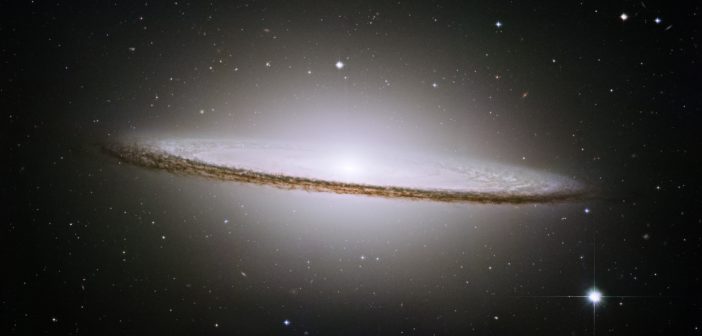What’s going on in the galactic bulge? The discovery of the double red clump — two groupings of stars seen in the color-magnitude diagram of the galactic bulge — has raised questions about the structure and formation history of the stars surrounding the center of our galaxy.

A color-magnitude diagram of the galactic bulge from the Two Micron All Sky Survey. In panel b, the red, blue, and black symbols indicate the bright red clump, faint red clump, and background red giant branch stars, respectively. The double red clump is more clearly visible in the luminosity function in panel c. [Lee et al. 2018]
Two Theories for the Double Red Clump
The double red clump, which is separated into bright and faint components, has inspired various theories about its origin:
- X-shaped structure scenario: The presence of the double red clump was initially thought to indicate that the Milky Way bulge contains an X-shaped structure similar to that seen in other galaxies. The difference in apparent magnitude between the two components of the double red clump is simply due to the different distances to two of the arms of the structure as seen by an observer on Earth, with the arm reaching toward Earth forming the bright red clump and the arm stretching away from Earth forming the faint red clump.
- Multiple-population scenario: Alternatively, the double red clump could be composed of multiple generations of stars that formed in globular clusters, where later generations of stars would be enhanced in helium, nitrogen, and sodium. Stellar evolution models predict that the first-generation stars would be fainter than subsequent generations, so the magnitude difference between the bright and faint components would be due to intrinsic luminosity differences between the two populations.

An illustration of the expected magnitude versus CN strength plots for the competing scenarios. Click to enlarge. [Lee et al. 2018]
A Closer Look at Red Clump Stars
How can we distinguish between these two scenarios? Young-Wook Lee (Yonsei University, South Korea) and collaborators posited that these theories can be separated by taking a closer look at the spectra of the double red clump stars.
Using low-resolution spectroscopy from a 2.5-meter telescope at Las Campanas Observatory, Lee and collaborators set out to measure the CN band strength of nearly 500 stars in the double red clump. Why CN? The CN band strength correlates with the nitrogen abundance, which is expected to be enhanced in later generations of stars.
If the two components of the double red clump represent separate generations of stars, the brighter stars will show the expected nitrogen enhancement. If, on the other hand, the double red clump arises from an X-shaped structure in the galactic bulge, there will be no difference in CN band strength between the bright and faint components.

CN indices for bright red clump (red), faint red clump (blue), and red giant branch (black) stars. Click to enlarge. [Lee et al. 2018]
From Globular Clusters to Galactic Bulges?
By comparing the spectra of the bright and faint red clump stars, Lee and collaborators found that the bright population had stronger CN absorption than the faint population at the 5.3σ level.
While precise parallax distances from Gaia and high-resolution spectroscopy are still needed to completely disentangle the stellar populations near the heart of our galaxy, this result supports the theory that the double red clump contains multiple generations of stars. The abundance patterns inferred from the stars’ spectra imply that the double red clump stars may have formed in young globular clusters, which could have profound implications for how galactic bulges are assembled — in both our home galaxy and afar.
Citation
Young-Wook Lee et al 2018 ApJL 862 L8. doi:10.3847/2041-8213/aad192
